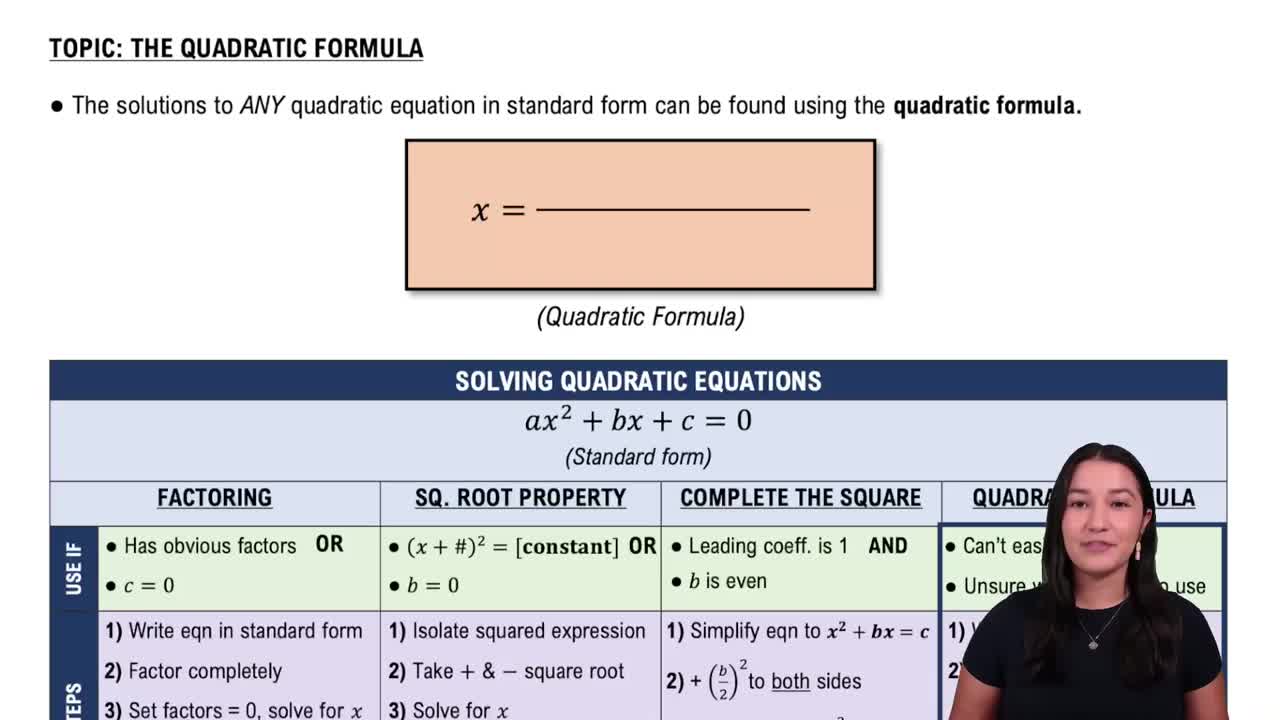Table of contents
- 0. Review of Algebra4h 16m
- 1. Equations & Inequalities3h 18m
- 2. Graphs of Equations43m
- 3. Functions2h 17m
- 4. Polynomial Functions1h 44m
- 5. Rational Functions1h 23m
- 6. Exponential & Logarithmic Functions2h 28m
- 7. Systems of Equations & Matrices4h 6m
- 8. Conic Sections2h 23m
- 9. Sequences, Series, & Induction1h 19m
- 10. Combinatorics & Probability1h 45m
7. Systems of Equations & Matrices
Two Variable Systems of Linear Equations
Problem 79a
Textbook Question
Use a system of equations to solve each problem. See Example 8. Find an equation of the parabola y = ax^2 + bx + c that passes through the points (2, 3), (-1, 0), and (-2, 2).
 Verified step by step guidance
Verified step by step guidance1
Substitute each given point into the general form of the parabola equation, y = ax^2 + bx + c, to create a system of equations. For point (2, 3), substitute x = 2 and y = 3 to get the first equation. For point (-1, 0), substitute x = -1 and y = 0 to get the second equation. For point (-2, 2), substitute x = -2 and y = 2 to get the third equation.
Write out the system of equations derived from the substitutions. You will have three equations with three unknowns (a, b, and c).
Use a method such as substitution or elimination to solve the system of equations for a, b, and c. Start by solving one of the equations for one variable in terms of the others, then substitute this expression into the other equations.
Once you have values for a, b, and c, substitute them back into the general form of the parabola equation, y = ax^2 + bx + c, to get the specific equation of the parabola that passes through the given points.
Check your solution by substituting the x-values of the given points into your final equation to see if they yield the corresponding y-values, ensuring the accuracy of your equation.
Recommended similar problem, with video answer:
 Verified Solution
Verified SolutionThis video solution was recommended by our tutors as helpful for the problem above
Video duration:
6mPlay a video:
Was this helpful?
Key Concepts
Here are the essential concepts you must grasp in order to answer the question correctly.
System of Equations
A system of equations consists of two or more equations that share common variables. To solve such a system, one seeks values for the variables that satisfy all equations simultaneously. In this context, the system will be formed by substituting the given points into the general form of a parabola, leading to a set of equations that can be solved for the coefficients a, b, and c.
Recommended video:
Guided course

Introduction to Systems of Linear Equations
Quadratic Function
A quadratic function is a polynomial function of degree two, typically expressed in the form y = ax^2 + bx + c, where a, b, and c are constants. The graph of a quadratic function is a parabola, which can open upwards or downwards depending on the sign of the coefficient a. Understanding the properties of parabolas, such as their vertex and axis of symmetry, is essential for analyzing their behavior and solving related problems.
Recommended video:

Solving Quadratic Equations Using The Quadratic Formula
Substitution Method
The substitution method is a technique used to solve systems of equations by expressing one variable in terms of another and substituting this expression into the other equations. In the context of this problem, after forming the equations from the points, one can isolate one of the coefficients (a, b, or c) and substitute it into the other equations to simplify the system, ultimately leading to a solution for all coefficients.
Recommended video:

Choosing a Method to Solve Quadratics

 4:27m
4:27mWatch next
Master Introduction to Systems of Linear Equations with a bite sized video explanation from Patrick Ford
Start learningRelated Videos
Related Practice












